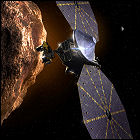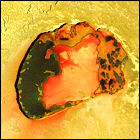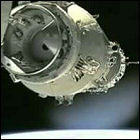 NASA launches the Lucy spacecraft on its twelve-year mission to study select specimens of the Trojan asteroid swarms that both precede and trail the planet Jupiter at the stable LaGrange points in its orbit. Lucy’s complex trajectory calls for it to conduct gravity assist flybys of Earth in 2022 and 2024, and to survey the main asteroid belt body 52246 Donaldjohanson in 2025, en route to reaching its first Trojan asteroid, 3548 Eurybates, in 2027. Future targets include 15094 Polymele later in 2027, 11351 Leucus and 21900 Orus in 2028, and – after a further gravity assist flyby of Earth in 2030 – the binary Trojan pair 617 Patroclus-Menoetius in 2033. Lucy’s name is not an abbreviation; it is named after a famous fossil skeleton discovered in 1971 by a team led by anthropologist David Johanson; it is hoped that studying the Trojan asteroids will lead to discoveries that make them similar “missing links” in the solar system’s own fossil record.
NASA launches the Lucy spacecraft on its twelve-year mission to study select specimens of the Trojan asteroid swarms that both precede and trail the planet Jupiter at the stable LaGrange points in its orbit. Lucy’s complex trajectory calls for it to conduct gravity assist flybys of Earth in 2022 and 2024, and to survey the main asteroid belt body 52246 Donaldjohanson in 2025, en route to reaching its first Trojan asteroid, 3548 Eurybates, in 2027. Future targets include 15094 Polymele later in 2027, 11351 Leucus and 21900 Orus in 2028, and – after a further gravity assist flyby of Earth in 2030 – the binary Trojan pair 617 Patroclus-Menoetius in 2033. Lucy’s name is not an abbreviation; it is named after a famous fossil skeleton discovered in 1971 by a team led by anthropologist David Johanson; it is hoped that studying the Trojan asteroids will lead to discoveries that make them similar “missing links” in the solar system’s own fossil record.
 The second episode of the sequel series Team Knight Rider airs in syndication, starring Brixton Karnes, Christine Steel, Duane Davis, and Nick Wechsler.
The second episode of the sequel series Team Knight Rider airs in syndication, starring Brixton Karnes, Christine Steel, Duane Davis, and Nick Wechsler.
 The 68th episode of Gene Roddenberry’s Earth: Final Conflict, airs in syndication, starring Robert Leeshock, Jayne Heitmeyer, and Von Flores.
The 68th episode of Gene Roddenberry’s Earth: Final Conflict, airs in syndication, starring Robert Leeshock, Jayne Heitmeyer, and Von Flores.  NASA/JPL’s Galileo unmanned space probe makes the closest flybys yet of Io, the volcanically hyperactive moon of Jupiter which made headlines when Voyager scientists spotted an eruption in 1980. The new images give the best view yet of Io’s inhospitable surface, including a volcanic crater, 47 miles across, named after the Brazilian god of thunder, Tupan Patera – an eye-searingly colorful region even in natural light.
NASA/JPL’s Galileo unmanned space probe makes the closest flybys yet of Io, the volcanically hyperactive moon of Jupiter which made headlines when Voyager scientists spotted an eruption in 1980. The new images give the best view yet of Io’s inhospitable surface, including a volcanic crater, 47 miles across, named after the Brazilian god of thunder, Tupan Patera – an eye-searingly colorful region even in natural light. The 104th episode of Joss Whedon’s supernatural series Buffy The Vampire Slayer, starring Sarah Michelle Gellar, airs on UPN. James Marsters, Anthony Stewart Head, and Alyson Hannigan also star.
The 104th episode of Joss Whedon’s supernatural series Buffy The Vampire Slayer, starring Sarah Michelle Gellar, airs on UPN. James Marsters, Anthony Stewart Head, and Alyson Hannigan also star. The second episode of the superhero series Birds Of Prey, based on characters from the DC Comics universe, airs on the WB, starring Ashley Scott, Dina Meyer, Rachel Skarsten, Shemar Moore, Ian Abercrombie, and Mia Sara.
The second episode of the superhero series Birds Of Prey, based on characters from the DC Comics universe, airs on the WB, starring Ashley Scott, Dina Meyer, Rachel Skarsten, Shemar Moore, Ian Abercrombie, and Mia Sara. The
The  The 25th episode of Arrow, a modern-day reboot of DC Comics’ Green Arrow superhero starring Stephen Amell, airs on the CW. Michael Jai White (For Better Or Worse, Black Dynamite) guest stars.
The 25th episode of Arrow, a modern-day reboot of DC Comics’ Green Arrow superhero starring Stephen Amell, airs on the CW. Michael Jai White (For Better Or Worse, Black Dynamite) guest stars. HBO premieres the
HBO premieres the  China’s Shenzhou 11 mission is launched, the country’s sixth crewed flight, with a two-man crew consisting of Jing Haipeng (veteran of the Shenzhou 7 and Shenzhou 9 missions) and rookie taikonaut Chen Dong. The vehicle’s destination is the
China’s Shenzhou 11 mission is launched, the country’s sixth crewed flight, with a two-man crew consisting of Jing Haipeng (veteran of the Shenzhou 7 and Shenzhou 9 missions) and rookie taikonaut Chen Dong. The vehicle’s destination is the  Cable channel Disney XD airs the
Cable channel Disney XD airs the  The CW airs the 93rd episode of The Flash, a modern-day reboot of DC Comics’ superhero starring Grant Gustin.
The CW airs the 93rd episode of The Flash, a modern-day reboot of DC Comics’ superhero starring Grant Gustin. NASA launches the Lucy spacecraft on its twelve-year mission to study select specimens of the Trojan asteroid swarms that both precede and trail the planet Jupiter at the stable LaGrange points in its orbit. Lucy’s complex trajectory calls for it to conduct gravity assist flybys of Earth in 2022 and 2024, and to survey the main asteroid belt body 52246 Donaldjohanson in 2025, en route to reaching its first Trojan asteroid, 3548 Eurybates, in 2027. Future targets include 15094 Polymele later in 2027, 11351 Leucus and 21900 Orus in 2028, and – after a further gravity assist flyby of Earth in 2030 – the binary Trojan pair 617 Patroclus-Menoetius in 2033. Lucy’s name is not an abbreviation; it is named after a famous fossil skeleton discovered in 1971 by a team led by anthropologist David Johanson; it is hoped that studying the Trojan asteroids will lead to discoveries that make them similar “missing links” in the solar system’s own fossil record.
NASA launches the Lucy spacecraft on its twelve-year mission to study select specimens of the Trojan asteroid swarms that both precede and trail the planet Jupiter at the stable LaGrange points in its orbit. Lucy’s complex trajectory calls for it to conduct gravity assist flybys of Earth in 2022 and 2024, and to survey the main asteroid belt body 52246 Donaldjohanson in 2025, en route to reaching its first Trojan asteroid, 3548 Eurybates, in 2027. Future targets include 15094 Polymele later in 2027, 11351 Leucus and 21900 Orus in 2028, and – after a further gravity assist flyby of Earth in 2030 – the binary Trojan pair 617 Patroclus-Menoetius in 2033. Lucy’s name is not an abbreviation; it is named after a famous fossil skeleton discovered in 1971 by a team led by anthropologist David Johanson; it is hoped that studying the Trojan asteroids will lead to discoveries that make them similar “missing links” in the solar system’s own fossil record.